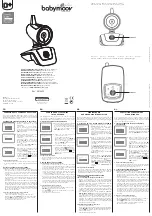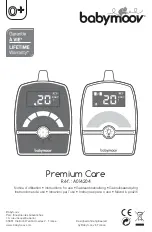
1-3
Neonate to Adults. Every available parameter may be easily accessed and adjusted to the unique
needs, condition and situation of each patient.
1.2
Power Supply.
Power is supplied to this monitors operational circuits by the AB69 and
AB69A Power Supply Boards. AB69 and AB69A 12 Vdc, -12 Vdc, +5 Vdc, -5 Vdc and
+3 Vdc to the different operational areas of the
Millennia
®
3155 MVS/3155A Monitor
. This power
is used to run the recorder, provide alarm audio drive to the speaker and to provide front-panel LED
illumination as an indication of the state of the input power and the condition of the batteries. In
terms of the battery system: the AB69 and AB69A boards charge and monitor the charge-state of
the batteries, provide operation from the batteries in the event of power failure or AC Line Power
adapter disconnection, issues an early warning when the batteries are low and provides for controlled
shut down of the monitor when the batteries are discharged.
1.2.1
AB69 and AB69A Location. The AB69 and AB69A Power Supply Boards are stacked with
the AB69A on top. They are located immediately in front of the Processor Motherboard in the center
of the case.
1.2.2
Charger Circuit. The charger circuit is located on the AB69A board (upper board, on the left
half of the board. Please refer to the left half of drawing 185C197. The circuit is a buck-type
switching regulator with current limiting and a charge-cutoff circuit.
Consider the charger switcher first: Q1, the current switch transistor, is driven by transistor Q4. A
typical cycle of switching proceeds as follows: transistor Q1 turns on and applies the supply voltage
(typically 18 to 14 volts) to inductor L1. The current through inductor L1 ramps up until the
voltage across resistor R17, and the voltage between the emitter and the base of transistor Q3 rises
enough to turn on transistor Q3. When transistor Q3 turns on, it shorts out the base-emitter drive
into transistor Q2, and Q2 turns off. Transistor Q4 shuts off as there is now no current through
resistor R14, and thus no voltage drop. When transistor Q4 turns off, transistor Q1 has no drive, and
its output voltage falls to zero. The current through inductor L1 decays according to its
time-constant, with diode D8 supplying the decaying current. Capacitor C4 smooths the output
voltage from inductor L1. The overall action produces a set of rising and falling current-ramp
waveforms that average out to a controlled charging current into the battery.
When the battery has charged sufficiently, the voltage on op amp U1 pin 2 now rises above the
voltage on pin 3, and pin 1's voltage falls to ground. This forward-biases diode D3 with current
being drawn through resistors R9 and R11. The voltage across resistor R11 is now enough to turn
on transistor Q5. When transistor Q5 turns on, the base-emitter voltage across transistor Q2
becomes zero, and transistor Q2 turns off. This action will override the switching action just
described and turn the charger off. The charger stays off until the battery voltage drops enough to
initiate charging.
When the voltage on U1 pin 2 falls below that of pin 3, then pin 1 of U1 rises, turning off diode D3,
and allowing the transistor Q2 to again have bias. The charger restarts. The circuit of resistor R8
and the diode D4 apply hysterises to avoid rapid charger cycling. Typically, the charger stops
charging at approximately 15.4 volts and restarts at approximately 13.2 volts.
A trickle current is supplied to the batteries by the resistors R12 and R20. This current is about
17mA, safe for a single battery (worst case). If the battery voltage is very low (about 7 volts), then
U1 pin 6 has a lower voltage than U1 pin 5, and pin 7 of U1 is high. Current flows through diode
D1, keeping pin 2 of U1 at a voltage greater than pin 3, keeping the charger off.
Voltage regulator U2 provides a temperature-adjusted voltage (matching the temperature coefficient
of the battery by using diodes D5, D6, and D7) for comparing with the battery voltage. Diode D9
prevents the battery from discharging through the charger circuit when no line power is available.
The charger may be shut off by turning ON transistor Q7 from the CHGSHUTDWN line (connector
Содержание Millennia 3155A
Страница 2: ......
Страница 4: ......
Страница 12: ...viii THIS PAGE INTENTIONALLY LEFT BLANK...
Страница 32: ...2 12 THIS PAGE INTENTIONALLY LEFT BLANK...
Страница 52: ...5 10 THIS PAGE INTENTIONALLY LEFT BLANK...
Страница 54: ...6 2...
Страница 55: ...6 3...
Страница 56: ...6 4...
Страница 57: ...6 5...
Страница 58: ...6 6...
Страница 59: ...6 7...
Страница 60: ...6 8...
Страница 61: ...6 9...
Страница 62: ...6 10...
Страница 63: ...A 1 APPENDIX A LIST OF SYMBOLS...
Страница 64: ...A 2 THIS PAGE INTENTIONALLY LEFT BLANK...
Страница 68: ...C 2 THIS PAGE INTENTIONALLY LEFT BLANK...
Страница 71: ...NOTES...
Страница 72: ......
Страница 73: ......
Страница 74: ......
Страница 75: ......
Страница 76: ......
















































